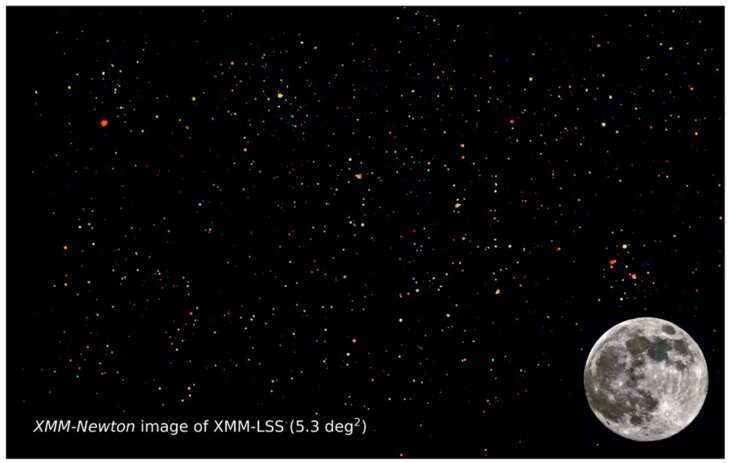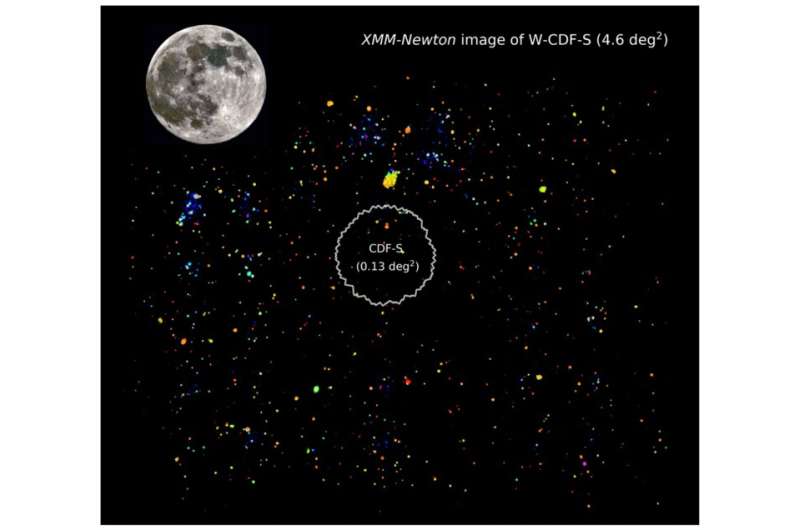One of the largest X-ray surveys using the European Space Agency's XMM-Newton space observatory has mapped nearly 12,000 X-ray sources across three large, prime regions of the sky. The X-ray sources represent active galactic nuclei and galaxy clusters, and the survey captures the growth of the supermassive black holes at the cores of these galaxies. This X-ray survey complements previous X-ray surveys, allowing the researchers to map active galactic nuclei in a wide range of cosmic environments.
Qingling Ni and W. Niel Brandt from Penn State will present the results of the XMM-Spitzer Extragalactic Representative Volume Survey (XMM-SERVS) at a press briefing being held Monday, June 7, at 4:30 p.m. during the 238th meeting of the American Astronomical Society. A paper describing the survey, by an international team of astronomers, has been submitted to the Astrophysical Journal Supplement.
"X-ray surveys are the best way to find growing supermassive black holes, which are located at the cores of many large galaxies," said Ni, a graduate student at Penn State and lead author of the paper. "With this massive new survey, we can access population data about growing supermassive black holes to better understand their physical properties and evolution over cosmic history."
Currently available X-ray surveys are primarily either deep "pencil-beam" surveys covering a very small part of the sky or shallow surveys covering large sky areas. Deep pencil-beam surveys can only sample active galactic nuclei in a limited cosmic volume, and they lack the ability to explore a wide dynamic range of cosmic environments. Shallow, wide-field surveys can sample a wider variety of environments but lack the sensitivity to detect the bulk of cosmic supermassive black hole growth.

The new XMM-SERVS survey helps to fill the gap between deep pencil-beam X-ray surveys and shallow X-ray surveys over large sky areas. The XMM-SERVS survey provides medium-deep X-ray coverage for three widely separated sky fields that have previously been studied at multiple wavelengths. Additionally, these regions have been selected as Deep-Drilling Fields of the Legacy Survey of Space and Time (LSST) to be conducted by the Vera C. Rubin Observatory. The Rubin Observatory is an 8.4-meter giant survey telescope located in north-central Chile, which is presently being constructed at a cost of more than $600 million. It represents one of the largest investments of the worldwide astronomical community in this decade.
The LSST Deep-Drilling Fields are sky regions where substantially more observations will be obtained compared to typical sky regions during the ten-year LSST survey, enabling new scientific discoveries. The XMM-SERVS survey fields are also the sites of multiple other upcoming surveys at radio, submillimeter, infrared, and optical wavelengths. One of the XMM-SERVS survey fields is also among the Deep Fields of the €600-million space mission Euclid that will launch in 2022. Thus, the X-ray coverage provided by XMM-SERVS has enormous legacy value in conjunction with these other rich datasets.
"These sky fields span a wide variety of cosmic environments," said Ni. "So we are getting a view of supermassive black hole growth that is hopefully unbiased by local cosmic factors. Additionally, over the past decade astronomers have established that there is a strong correlation between black-hole growth and the properties of galaxies, but the limited sample size restricted these studies to proper investigation of only a few galaxy parameters. Our new large sample of growing supermassive black holes will allow us to look at many more galaxy parameters together."

The fields covered by the XMM-SERVS survey are the Wide Chandra Deep Field-South (W-CDF-S), the European Large-Area Infrared Space Observatory S1 Survey (ELAIS-S1), and the XMM-Newton Large-Scale Structure Survey (XMM-LSS). These sky areas, each spanning a few square degrees, are already among the best-studied fields in the sky, and with the coming LSST and other coverage they will be prime next-generation survey fields.
"This survey represents key foundational work upon which, I suspect, hundreds of studies will be built over the next decade or two," said Brandt, Verne M. Willaman Professor of Astronomy and Astrophysics and professor of physics at Penn State, and one of the leaders of the study. "XMM-Newton was the best mission to gather these data, and we needed to invest a lot of observation time for this study—with a total combined exposure of nearly 60 days—because it will be so important for active galaxy studies, galaxy cluster studies, and for understanding large-scale structures in the universe. It required a multiyear, multinational effort and it's incredibly gratifying to get it done. We are most grateful to the European Space Agency and NASA for their long-term support of this work."



